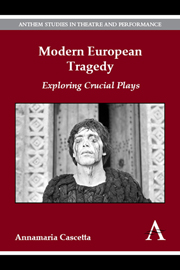Book contents
- Frontmatter
- Dedication
- Contents
- Acknowledgements
- Introduction: The Tragic, Tragedy and the Idea of the Limit
- Chapter 1 Hubris and Guilt: Gengangere (Ghosts)
- Chapter 2 Eve Becomes Mary: L'annonce faite à Marie (The Tidings Brought to Mary)
- Chapter 3 The School of Hatred: Mourning Becomes Electra
- Chapter 4 The Destiny of Man Is Man: Mutter Courage und ihre Kinder (Mother Courage and Her Children)
- Chapter 5 The Tragic and the Absurd: Caligula
- Chapter 6 Dianoetic Laughter in Tragedy: Accepting Finitude: Endgame
- Chapter 7 The Arrogance of Reason and the ‘Disappearance of the Fireflies’: Pilade (Pylades)
- Chapter 8 The Apocalypse of a Civilization: From Akropolis to Apocalypsis cum figuris
- A Provisional Epilogue: Between the Experience and the Representation of the Tragic: Towards a Performative Theatre
- Appendix: Chronology of Productions
- Notes
- Index
Chapter 6 - Dianoetic Laughter in Tragedy: Accepting Finitude: Endgame
Published online by Cambridge University Press: 05 September 2014
- Frontmatter
- Dedication
- Contents
- Acknowledgements
- Introduction: The Tragic, Tragedy and the Idea of the Limit
- Chapter 1 Hubris and Guilt: Gengangere (Ghosts)
- Chapter 2 Eve Becomes Mary: L'annonce faite à Marie (The Tidings Brought to Mary)
- Chapter 3 The School of Hatred: Mourning Becomes Electra
- Chapter 4 The Destiny of Man Is Man: Mutter Courage und ihre Kinder (Mother Courage and Her Children)
- Chapter 5 The Tragic and the Absurd: Caligula
- Chapter 6 Dianoetic Laughter in Tragedy: Accepting Finitude: Endgame
- Chapter 7 The Arrogance of Reason and the ‘Disappearance of the Fireflies’: Pilade (Pylades)
- Chapter 8 The Apocalypse of a Civilization: From Akropolis to Apocalypsis cum figuris
- A Provisional Epilogue: Between the Experience and the Representation of the Tragic: Towards a Performative Theatre
- Appendix: Chronology of Productions
- Notes
- Index
Summary
‘He's crying. […] Then he's living’: Weeping and Life
Hamm wonders whether old Nagg is dead yet. Clov replies that he appears not to be and adds, ‘He's crying.’ Hamm replies, ‘Then he's living. (Pause.) Did you ever have an instant of happiness?’
In Beckett, as in the earliest perception of the tragic in the West, weeping is an inextricable part of human life, a sign of living. And yet, as Nell has observed in an earlier passage in the work: ‘Nothing is funnier than unhappiness […]. Yes, yes, it's the most comical thing in the world.’
A refined lover of language and the startling syntheses of significance that it can evoke, Beckett plays on the ambiguity of ‘funny’, as both peculiar and comic, so giving us a glimpse of two different sets of implications. The tragedy of the human condition, arising out of the inescapable limit imposed by suffering, is both inexplicable and disturbing, yet it can be distanced and controlled by the comic vision and laughter.
We can take this as the starting point for exploring of one of the outstanding responses in the literature and theatre of the twentieth century to the central issue of tragedy, which Beckett embodied in all his works, but with the greatest complexity and incisiveness in Endgame, which he described as ‘the favourite of my plays’.
- Type
- Chapter
- Information
- Modern European TragedyExploring Crucial Plays, pp. 91 - 100Publisher: Anthem PressPrint publication year: 2014

